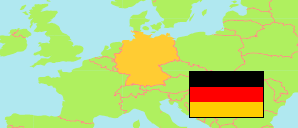
Wittmund
County in Lower Saxony
County
The population of Wittmund.
| Name | Status | Population Census 2011-05-09 | |
|---|---|---|---|
| Wittmund | County | 56,839 | → |
| Niedersachsen [Lower Saxony] | State | 7,777,992 |
Contents: Settlements
The population of the settlements in Wittmund.
| Name | Status | County | Population Census 2011-05-09 | |
|---|---|---|---|---|
| Addenhausen | Settlement | Wittmund | 510 | → |
| Angelsburg | Settlement | Wittmund | 840 | → |
| Ardorf | Settlement | Wittmund | 700 | → |
| Blomberg | Settlement | Wittmund | 1,050 | → |
| Burhafe | Settlement | Wittmund | 1,200 | → |
| Carolinensiel | Settlement | Wittmund | 1,380 | → |
| Esens | Settlement | Wittmund | 6,840 | → |
| Friedeburg | Settlement | Wittmund | 2,900 | → |
| Holtgast | Settlement | Wittmund | 850 | → |
| Horsten | Settlement | Wittmund | 1,870 | → |
| Langeoog | Settlement | Wittmund | 1,730 | → |
| Leerhafe | Settlement | Wittmund | 1,090 | → |
| Marx | Settlement | Wittmund | 590 | → |
| Nenndorf | Settlement | Wittmund | 560 | → |
| Reepsholt | Settlement | Wittmund | 560 | → |
| Riepen | Settlement | Wittmund | 550 | → |
| Schweindorf | Settlement | Wittmund | 580 | → |
| Spiekeroog | Settlement | Wittmund | 610 | → |
| Utarp | Settlement | Wittmund | 520 | → |
| Werdum | Settlement | Wittmund | 540 | → |
| Westerholt | Settlement | Wittmund | 2,030 | → |
| Wittmund | Settlement | Wittmund | 9,010 | → |
Source: Boundaries and population of settlements are computed by »City Population« using population figures in a 100m grid provided by the Statistisches Bundesamt Deutschland (web) and using geospatial data of the Bundesamt für Kartographie und Geodäsie (web). The settlements are delimited by unsettled and not built-up areas as well as by municipal boundaries.
Because of the computation method, the above population figures are not exact and therefore rounded. Area figures are derived from geospatial data.